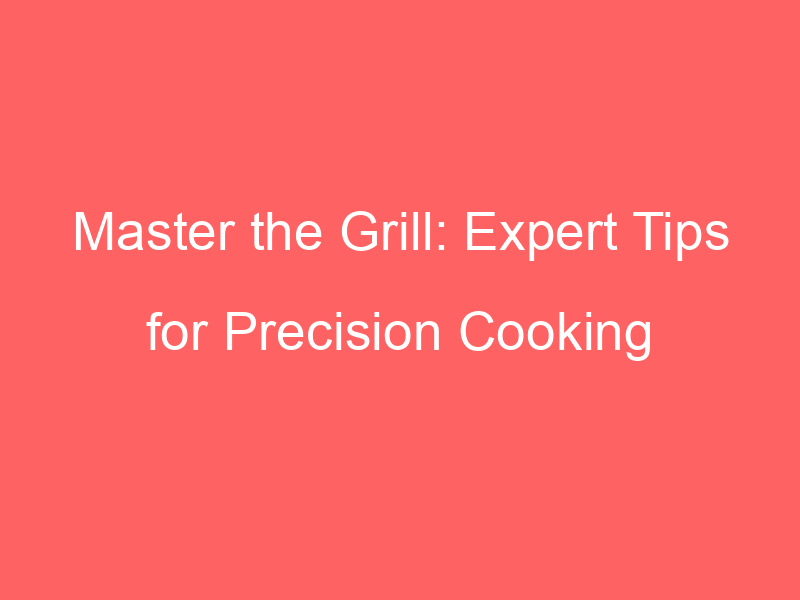Introduction to Precision Grilling
Welcome to the exciting world of precision grilling! This is a cooking method that combines science and art, allowing you to create delicious and perfectly cooked meals every time. Let’s dive into the concept of precision grilling and understand why it’s so important in outdoor cooking.
- Understanding the concept of precision grilling
- Importance of precision in outdoor cooking
Precision grilling is all about controlling the heat and cooking time to achieve the perfect result. It’s not just about throwing food on the grill and hoping for the best. Instead, it’s about understanding how different foods react to heat, and adjusting your grilling technique accordingly. For example, a thick steak needs a high heat to sear the outside and a lower heat to cook the inside to the desired doneness. On the other hand, delicate foods like fish require a more gentle heat to avoid overcooking.
Outdoor cooking is a fun and rewarding experience, but it can also be challenging. The weather, the type of grill, and the food you’re cooking can all affect the outcome. That’s where precision comes in. By understanding and controlling the cooking process, you can ensure that your food is cooked to perfection every time, regardless of the conditions. This not only improves the taste and texture of your food, but also ensures that it’s safe to eat. Remember, undercooked food can be a health risk!
So, are you ready to take your grilling to the next level? Stay tuned as we delve deeper into grilling techniques for precision cooking, share cooking tips for the perfect grilling experience, and provide a comprehensive grill cooking guide. By the end of this series, you’ll be a master of precision grilling!
Grilling Techniques for Precision Cooking
Understanding Your Grill
Grilling is an art, and like any art, it requires the right tools. Understanding your grill is the first step towards achieving precision cooking. Let’s delve into the different types of grills and how to choose the right one for your needs.
- Types of grills and their unique features
- Charcoal Grills: These grills use charcoal briquettes for cooking. They are loved for the smoky flavor they impart to the food. However, they take longer to heat up and require more cleanup.
- Gas Grills: Gas grills are convenient and easy to use. They heat up quickly and offer excellent control over the cooking temperature. However, they may not provide the same smoky flavor as charcoal grills.
- Electric Grills: These grills are perfect for those who live in apartments or places where gas and charcoal grills are not allowed. They are easy to use and clean, but the flavor may not be as robust as other types.
- Pellet Grills: Pellet grills use wood pellets for heat and smoke. They are versatile and can be used for grilling, smoking, and even baking. However, they can be more expensive than other types of grills.
- How to choose the right grill for your needs
- Your Budget: Grills can range in price from affordable to high-end. Determine how much you are willing to spend before you start shopping.
- Your Space: Consider the space where you will be grilling. If you have a small patio or balcony, a large grill may not be the best choice.
- Your Cooking Style: If you love the smoky flavor of charcoal-grilled food, a charcoal grill may be your best bet. If convenience is more important, consider a gas or electric grill.
- Features: Some grills come with added features like side burners, storage cabinets, and temperature gauges. Think about which features are important to you.
There are several types of grills, each with its unique features. Here are the most common ones:
Choosing the right grill depends on several factors. Here are some things to consider:
In conclusion, understanding your grill is crucial for precision cooking. By knowing the types of grills and how to choose the right one, you can take your grilling skills to the next level.
Temperature Control
When it comes to precision grilling, mastering temperature control is crucial. Let’s delve into why temperature control is so important and how you can maintain consistent grill temperatures.
- Understanding the importance of temperature control in grilling
Temperature control is the heart of grilling. It’s what separates a perfectly grilled steak from a burnt one. When you control the temperature of your grill, you have the power to cook your food exactly how you want it. Whether you’re aiming for a tender, juicy chicken or a well-seared steak, temperature control can make all the difference.
Did you know that different types of food require different grilling temperatures? For instance, poultry needs a higher temperature to ensure it’s fully cooked, while fish requires a lower temperature to avoid drying out. So, understanding temperature control is not just about getting your food to taste good, but also about ensuring it’s safe to eat.
- Techniques for maintaining consistent grill temperatures
Maintaining a consistent temperature on your grill might seem challenging, but with a few techniques, you can master it. Here are some tips:
- Preheat your grill: Just like an oven, a grill needs time to reach the desired temperature. Preheating your grill for 10-15 minutes will ensure it’s ready for cooking.
- Use a grill thermometer: A grill thermometer is a must-have tool for precision grilling. It allows you to monitor the temperature inside your grill without opening the lid and losing heat.
- Control the airflow: Most grills have vents that control the airflow. More airflow means higher temperatures, while less airflow reduces the temperature. Adjust these vents to control the heat.
- Manage your fuel: The amount of charcoal or gas you use directly impacts the temperature. Start with a moderate amount and add more if needed.
Remember, practice makes perfect. The more you grill, the better you’ll become at controlling the temperature and achieving your desired cooking results.
Time Management
One of the most crucial aspects of precision grilling is time management. Knowing how long to cook different foods and understanding the importance of timing can make all the difference in achieving that perfect grill.
- How to estimate cooking times for different foods
- Importance of timing in achieving perfect grilling
Estimating cooking times for different foods is not as complicated as it might seem. It’s all about understanding the type of food you’re grilling and its thickness. For instance, a 1-inch steak typically takes about 10-14 minutes to grill on medium heat. On the other hand, a chicken breast might take 15-20 minutes. Here’s a simple table to guide you:
| Food | Thickness | Estimated Cooking Time |
|---|---|---|
| Steak | 1 inch | 10-14 minutes |
| Chicken Breast | 1.5 inches | 15-20 minutes |
| Pork Chop | 1 inch | 14-18 minutes |
Remember, these are just estimates. Always check the internal temperature of your food to ensure it’s cooked to your desired level.
Timing is everything when it comes to grilling. Cook your food for too long, and it may end up burnt and dry. Cook it for too short, and it might be undercooked and unsafe to eat. The key to perfect grilling is to keep a close eye on your food and adjust the cooking time as needed. As the saying goes, “Watch the grill, not the clock.”
Mastering time management in grilling can take some practice, but once you get the hang of it, you’ll be on your way to achieving that perfect grill every time.
Cooking Tips for Perfect Grilling
Grilling is an art that requires precision and knowledge. Here are some tips to help you achieve perfect grilling every time.
Preparation Techniques
Before you even light the grill, there are a few things you need to do to ensure your food cooks perfectly. Let’s take a look at these preparation techniques.
- Choosing the Right Cuts of Meat for Grilling
- Marinating Techniques for Enhanced Flavor
Not all cuts of meat are created equal when it comes to grilling. The best cuts for grilling are those with a good balance of fat and lean meat. This includes cuts like ribeye, T-bone, and sirloin for beef; pork chops and tenderloin for pork; and thighs and drumsticks for chicken. These cuts stay juicy and flavorful even when exposed to the high heat of the grill.
Marinating your meat before grilling can enhance its flavor and tenderness. A good marinade usually contains an acid (like vinegar or citrus juice), oil, and seasonings. The acid helps tenderize the meat, while the oil and seasonings add flavor. For best results, marinate your meat in the refrigerator for at least 2 hours, but not more than 24 hours. Remember to remove the meat from the refrigerator about 30 minutes before grilling to allow it to come to room temperature.
With these preparation techniques, you’re well on your way to grilling perfection. Stay tuned for more cooking tips and techniques to help you master the art of grilling.
Cooking Techniques
Let’s dive into some essential cooking techniques that can help you grill with precision. We’ll discuss direct and indirect grilling methods and how to use grill zones for precision cooking.
- Direct vs Indirect Grilling Methods
- How to Use Grill Zones for Precision Cooking
- High heat zone: This is the hottest part of the grill, perfect for searing and browning food.
- Medium heat zone: This area is ideal for cooking food through after it’s been seared.
- Low heat zone: This is the coolest part of the grill, great for slow cooking or keeping food warm.
Direct grilling involves placing the food directly over the heat source. This method is perfect for grilling thin cuts of meat, vegetables, and fruits. It’s fast and gives your food a beautiful sear.
On the other hand, indirect grilling is when the food is placed away from the heat source. This method is ideal for larger cuts of meat or food that needs to cook slowly without burning. It’s like turning your grill into an outdoor oven!
Remember, the key to successful grilling is knowing when to use each method. For example, a thin steak would benefit from the high heat of direct grilling, while a whole chicken would be best cooked indirectly to ensure it cooks evenly.
Grill zones are areas of different temperatures on your grill. By using these zones, you can control the cooking process more precisely. Here’s how:
By understanding and using these zones, you can cook different foods at their ideal temperatures, all at the same time. This technique will help you become a master of precision grilling.
Remember, practice makes perfect. The more you grill, the better you’ll become at using these techniques. So, get out there and start grilling!
BBQ Tips for Outdoor Cooking
Outdoor cooking is a beloved pastime for many, especially when it involves a delicious BBQ. However, safety should always be our top priority. Here are some key safety tips to keep in mind.
Safety Tips
Whether you’re a seasoned grill master or a beginner, safety should always come first. Let’s dive into some essential safety tips for outdoor cooking.
- Fire Safety When Using a Grill
- Food Safety Tips for Outdoor Cooking
Fire safety is paramount when grilling. Always keep a fire extinguisher or a bucket of sand nearby to put out any unexpected flames. Never leave your grill unattended when it’s lit, and make sure to keep children and pets at a safe distance. Always turn off the propane tank first before turning off the BBQ to ensure no gas is left in the pipe.
Food safety is just as important as fire safety. Always wash your hands before handling food and after touching raw meat. Use separate utensils and plates for raw and cooked food to avoid cross-contamination. Keep your food at safe temperatures. Cooked food should not sit out for more than two hours, and in hot weather (above 90°F), it should not sit out for more than an hour.
Remember, safety first, then fun. Happy grilling!
BBQ Recipes
Who doesn’t love a good barbecue? Whether you’re a seasoned griller or a beginner, there’s always room to explore new recipes and techniques. In this section, we’ll delve into some classic and unique BBQ recipes that you can try for your next outdoor cooking adventure.
- Classic BBQ Recipes for Outdoor Cooking
When it comes to classic BBQ recipes, nothing beats the traditional grilled chicken or ribs. These recipes have stood the test of time and continue to be a favorite among BBQ enthusiasts. Here are a couple of classic BBQ recipes you can try:
| Recipe | Ingredients | Instructions |
|---|---|---|
| Classic BBQ Chicken | Chicken, BBQ Sauce, Salt, Pepper | Marinate the chicken in BBQ sauce for at least 2 hours. Season with salt and pepper. Grill over medium heat until cooked through. |
| BBQ Ribs | Ribs, BBQ Sauce, Brown Sugar, Salt, Pepper | Rub the ribs with a mixture of brown sugar, salt, and pepper. Grill over low heat for 2-3 hours. Brush with BBQ sauce in the last 30 minutes of grilling. |
- Unique BBQ Recipes to Try
For those who want to try something different, there are countless unique BBQ recipes out there. These recipes incorporate different ingredients and flavors, giving a fresh twist to your usual BBQ. Here are a couple of unique BBQ recipes you can try:
| Recipe | Ingredients | Instructions |
|---|---|---|
| Grilled Pineapple with Cinnamon Honey Drizzle | Pineapple, Honey, Cinnamon | Grill pineapple slices over medium heat until caramelized. Drizzle with a mixture of honey and cinnamon. |
| BBQ Tofu Skewers | Tofu, BBQ Sauce, Bell Peppers, Onions | Marinate tofu in BBQ sauce for at least 2 hours. Skewer with bell peppers and onions. Grill over medium heat until cooked through. |
Remember, the key to a successful BBQ is patience and precision. Keep these recipes in your arsenal and you’re sure to impress at your next outdoor cooking event.
Grill Cooking Guide
Grilling is an art, and like any art, it requires not only skill but also the right tools. One of those tools is a well-maintained grill. Let’s dive into some essential grill maintenance tips.
Grill Maintenance
Proper maintenance of your grill can significantly extend its lifespan and improve the quality of your cooking. Here are a few key tips:
- How to clean and maintain your grill for longevity
- Tips for winterizing your grill
Regular cleaning is crucial for the longevity of your grill. After each use, allow the grill to cool down, then use a grill brush to remove any leftover food particles. Once a month, give your grill a deep clean. Remove the grates and burners, and clean them with a mixture of warm water and dish soap. Rinely thoroughly and let them dry before reassembling.
If you live in a region with harsh winters, it’s important to winterize your grill. Start by giving it a thorough cleaning. Then, cover it with a heavy-duty grill cover to protect it from the elements. If possible, store it in a dry, sheltered area. Remember to check on your grill occasionally throughout the winter to ensure it’s still in good condition.
Maintaining your grill may seem like a chore, but it’s a small price to pay for the delicious meals you’ll be able to create. Plus, a well-maintained grill can last for years, saving you money in the long run.
Grill Accessories
Grill accessories are essential tools for every grilling enthusiast. They not only make your grilling process easier but also help in achieving precision cooking. Let’s delve into the must-have grill accessories and learn how to use them effectively.
- Must-have grill accessories for precision cooking
Grill accessories can transform your grilling experience, making it more efficient and enjoyable. Here are some must-have grill accessories for precision cooking:
| Accessory | Description |
|---|---|
| Grill Thermometer | A grill thermometer is a vital tool for precision cooking. It helps you monitor the temperature of your grill, ensuring your food is cooked perfectly. |
| Grill Tongs | Grill tongs are essential for flipping and moving food around on the grill. They should be long enough to keep your hands safe from the heat. |
| Grill Brush | A grill brush is used to clean the grill grates after cooking. It helps maintain the longevity of your grill. |
- How to use grill accessories effectively
Knowing how to use your grill accessories effectively can significantly improve your grilling experience. Here are some tips:
- Grill Thermometer: Always preheat your grill before cooking. Once it reaches the desired temperature, you can start grilling your food.
- Grill Tongs: Use your grill tongs to flip your food only once. Over-flipping can lead to uneven cooking.
- Grill Brush: Always clean your grill after each use. This prevents buildup and extends the life of your grill.
In conclusion, grill accessories are not just add-ons, but essential tools for precision cooking. By understanding their importance and learning how to use them effectively, you can master the art of grilling.
Conclusion: Mastering Precision Grilling
As we wrap up our journey into the world of precision grilling, it’s important to reflect on what we’ve learned and how we can apply these techniques and tips to our own grilling endeavors. Let’s take a moment to recap and solidify our newfound knowledge.
- Recap of grilling techniques and cooking tips
- Final thoughts on mastering the grill
Throughout this guide, we’ve explored a variety of grilling techniques that can help you achieve perfect results every time. We’ve learned about the importance of preheating the grill, the use of direct and indirect heat, and the benefits of using a meat thermometer for precision cooking. We’ve also discussed various cooking tips, such as marinating your meat for enhanced flavor and moisture, and the importance of letting your meat rest after grilling for optimal juiciness.
Mastering the grill is not just about knowing how to light it up and flip a burger. It’s about understanding how heat works, how different types of food react to it, and how to manipulate these factors to create a perfectly grilled dish. It’s about patience, practice, and a passion for grilling. With the techniques and tips we’ve discussed, you’re well on your way to becoming a true grill master.
Remember, the key to mastering precision grilling is practice. Don’t be discouraged if your first few attempts aren’t perfect. Keep trying, keep learning, and most importantly, keep grilling. As the famous chef Julia Child once said, “The only real stumbling block is fear of failure. In cooking, you’ve got to have a what-the-hell attitude.”
So, go ahead, fire up that grill and start your journey towards mastering precision grilling. Happy grilling!






